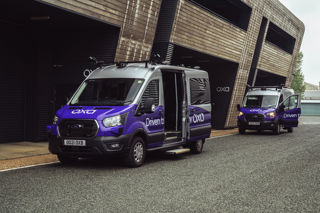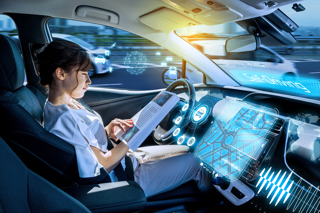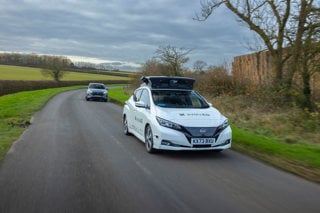Autonomous vehicles could initially lead to increased congestion, according to a new study by Arthur D Little (ADL).
Real-world simulation analysis by ADL demonstrates that switching to totally autonomous vehicles significantly reduces urban congestion by a factor of 10, but that mixing human and robot drivers together will increase traffic jams by over 16%.
The micro-simulation was based on a major intersection in Frankfurt. The five-lane highway includes two lanes turning left and one to the right, has a 80km/h speed limit, and is controlled by a traffic light. The simulation measured the impact of three scenarios on traffic within the two central lanes - 100% human drivers, a 50/50 split of human and robot drivers, and 100% autonomous vehicles with adapted traffic rules.
Forty-three vehicles would pass through each green phase of the intersection’s traffic light with 100% human drivers. This actually drops 16% to 36 vehicles with an equal mix of human and autonomous drivers, increasing congestion. This is mainly due to autonomous vehicles fully obeying the law and not taking risks when moving between lanes, unlike real-world human drivers.
In contrast, 506 vehicles pass through the light when switching to 100% autonomous vehicles and adopting optimized traffic rules, including reduced 2.5m distances between cars, allowing platooning, and a higher 90 km/h speed limit. This is feasible given that autonomous vehicles can react faster than human drivers to changing situations, avoiding sudden, hard braking and reducing accidents.
“Higher demand for mobility and greater urbanization are making congestion a growing issue within the world’s cities. Our micro-simulation found that while fully autonomous vehicles would solve this problem, the initial scenario we are likely to see, with a mix of robot and human drivers actually leads to greater traffic jams. Things would get worse before they get better. Clearly switching to 100% autonomous vehicles and changing traffic rules would require radical, disruptive action, posing serious questions for cities and society. Our work therefore aims to provide a starting point for further research and wider discussion, ahead of the future introduction of autonomous vehicles,” said Dr. Klaus Schmitz, partner at ADL.
The simulation was based on the Intelligent Driver model and was developed in conjunction with the University of Mannheim.






















John 4870 - 12/11/2018 10:59
In large cities this might work but - for the remaining 90% of the country fully autonomous cars are light years away. Costs will make this an unattractive option for most drivers for many years, and the simple practicalities of who fills them up, checks them etc when 24/7 filling stations are not common, will mean that this won't really happen in my lifetime (fortunately!)